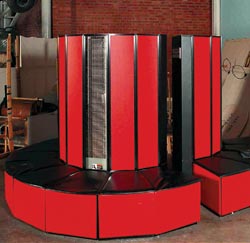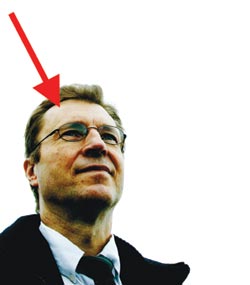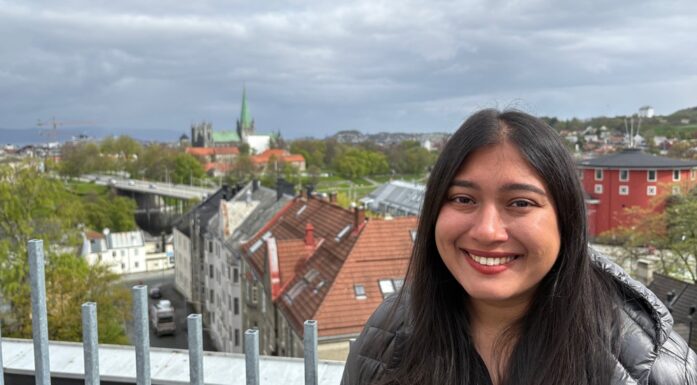Inventor of the GSM system
The Swedes and the Finns earn big money on mobile telephony. But the system they use is Norwegian.
If modern mobile telephony can be said to have originated anywhere, it would be with Torleiv Maseng (picture). In the 1980s, he worked in Trondheim and developed a standard that would revolutionise the world. “Perhaps the Norwegian system won out because we were really just a couple of friends playing around,” he says.
“Everybody else had big, cumbersome organisations, and a serious demand for profit.” Torleiv Maseng, promoter of mobile telephony, thinks back on the time.
It was 1987, and he was project leader at Sintef/Elab, which was working on Norway’s contribution to a radio element for the new European digital mobile telephone standard. In cooperation with Odd Trandem, he came up with an idea that became the foundation for a worldwide technological revolution.
FROM NORDIC TO EUROPEAN
In the 1980s, the analogue mobile telephone system NMT 900 had a monopoly in Scandinavia. Mobile phones of the day were big and heavy. They actually had to be mounted in cars to be «mobile». When Mr. Maseng joined SINTEF in 1981, a project from the Norwegian Telecom company and Scandinavia’s other telecom suppliers awaited him.
His task was to develop a new digital mobile telephone system for Scandinavia as a replacement for the NMT system. Before long, the Scandinavians merged with a pan-European project with the same goal. This project was led by the European Conference of Postal and Telecommunications Administrations – CEPT. At first, disagreements nearly crippled the entire integration process. Eventually, the EU intervened, and in 1987 the ball started rolling again. By then, 15 European countries had agreed to adopt the new standard proposed by CEPT.
A TOUR OF PARIS

One of the reasons Norway won the GSM standard competition in 1987 was the Cray supercomputer that came to NTH in 1986. Today, it is in storage at the Norwegian Museum of Science and Technology in Oslo.
Photo: Fredrik Oftebro, Norwegian Museum of Science and Technology
Several of the participating countries had long been working on their own systems and had developed very strong opinions about the way things ought to be. The CEPT companies therefore agreed to choose a winner based on objective testing.
In February 1987, eight systems from five different countries – Germany, France, Sweden, Finland and Norway – were in the running for creating the new standard. Some competitors were backed by major companies, such as Bosch, Philips, Mobira (Nokia) and Ericsson. Eight cars were outfitted with equipment from each candidate system.
The systems would be driven around Paris and the system’s transmission capacity and ability to continuously correct errors would be measured in the city’s narrow, windy streets. The system that transmitted the most data with the fewest errors would win. At first, the international press did not think the Norwegian GSM contribution was likely to win. In September 1986, the journal Communications Systems Worldwide wrote:
“Since ELAB is attached to a Technical institute and has no manufacturing capability, it would appear to have little chance of success.”
A CLEAR VICTOR
However, when the test was finished, the conclusion was clear: The Norwegian system was best. The British popular science journal New Scientist confused the source of the Norwegian system slightly when it described the victory as follows: The winner was a surprise. It was a system called ELAB, which was developed not by a large company, but by the University of Trondheim in Norway.
“We knew in advance,” says Torleiv Maseng with a smile, when Gemini met him at his current work place, the Norwegian Defence Research Establishment at Kjeller.
He says that Odd Trandem had simulated the test situation in Paris with the Norwegian system after the results from the other tests had been made public. He was able to do this because the Norwegian entry was the last to be tested in the competition. “The (simulated) results were so convincing we knew we would win,” Mr. Maseng says.
All those trips around Orkdals fjord to measure how the system would handle reflected signals and radio interference from the valley walls had not been in vain. And test rounds in Stockholm to see how the system would work in the city had borne fruit.
FJORDS AND MOUNTAINS
What was so special about the Norwegian system that enabled it to dominate the well-funded Germans and French entries?
“The most important reason we prevailed was that our system was the best in handling the interference created when radio signals are reflected by buildings and topography,” Mr. Maseng says.
“As the number of reflected signals increases, there is a greater chance that the radio transmitter or receiver gets confused and mixes up the signals. Norway has an abundance of those kinds of natural topographic challenges.”
A central concept in understanding how the system works is bandwidth. Bandwidth can be compared with the speed at which people talk. In this analogy, the faster you talk, the higher the bandwidth. But high bandwidth can be a problem in places with lots of reflected signals. The same problem explains why most hymns are sung slowly in church. If they are sung quickly, the acoustics of the church turn the hymn into an unintelligible mess.
This phenomenon also confounds radio signals. But Mr. Maseng and Mr. Trandem came up with a clever solution. The problem is that if the data speed is too high, the receiving equipment cannot deal with signals that ‘hang in the air’ at the same time, and the signal becomes chaotic. But if the bandwidth is too low, there is a greater chance that the signal will disappear because the receiving equipment cannot distinguish between different echoes.
Maseng and Trandem altered their bandwidth during testing; they could do this because they devised a way to see their results in real time. By doing this they were able to find the optimal bandwidth between the two extremes. Their competitors could not. The two researchers were clever, but they also had a powerful tool to help them: A Cray supercomputer, purchased by NTNU’s predecessor, NTH, in 1986. “The computing power of the Cray was a great help in finding the optimal bandwidth,” Odd Trandem says.
OUT INTO THE WORLD
Europe was a pioneer in mobile telephony. The United States developed many parallel telephone systems, but lacked a central coordinating authority. When the US discovered that Europe had developed a system that functioned well, American companies started developing a GSM system as well. The only difference between the USA and Europe was that the two frequencies reserved for mobile telephony in Europe were already taken in the US. That meant the Americans had to choose a new frequency range. You can see the result today in what are known as triband phones, offered by several phone manufacturers. A triband phone can send and receive European frequencies as well as American ones. The rest of the world soon adopted the GSM technology, and chose the same two frequencies as Europe.
TWO BILLION KRONER SAVED
The company destined to launch Norway into the mobile phone age was named Simonsen Elektro. For many years, Simonsen Elektro produced equipment for the NMT system. However, not enough money had been set aside for the new GSM system, and when Simonsen Elektro’s main partner, Elektrisk Bureau, was bought up by the Swedish company Ericsson, the purchase doomed Simonsen.
Ericsson and the Finnish company Nokia have become the leading mobile telephone companies worldwide – but their success is based on GSM technology originally developed in Norway. Nevertheless, Norway did not leave the business empty-handed – although the rewards were not what you might think. A research report published by the Norwegian Institute for Studies in Research and Higher Education (NIFU) concluded that the adoption of the Norwegian system saved Norway some NOK 2 billion (in 1986). The French–German system,which was the strongest competitor,was developed for a flatter landscape and would have required far more investment in aerial and base station equipment to function properly in Norway.
Even Gran





